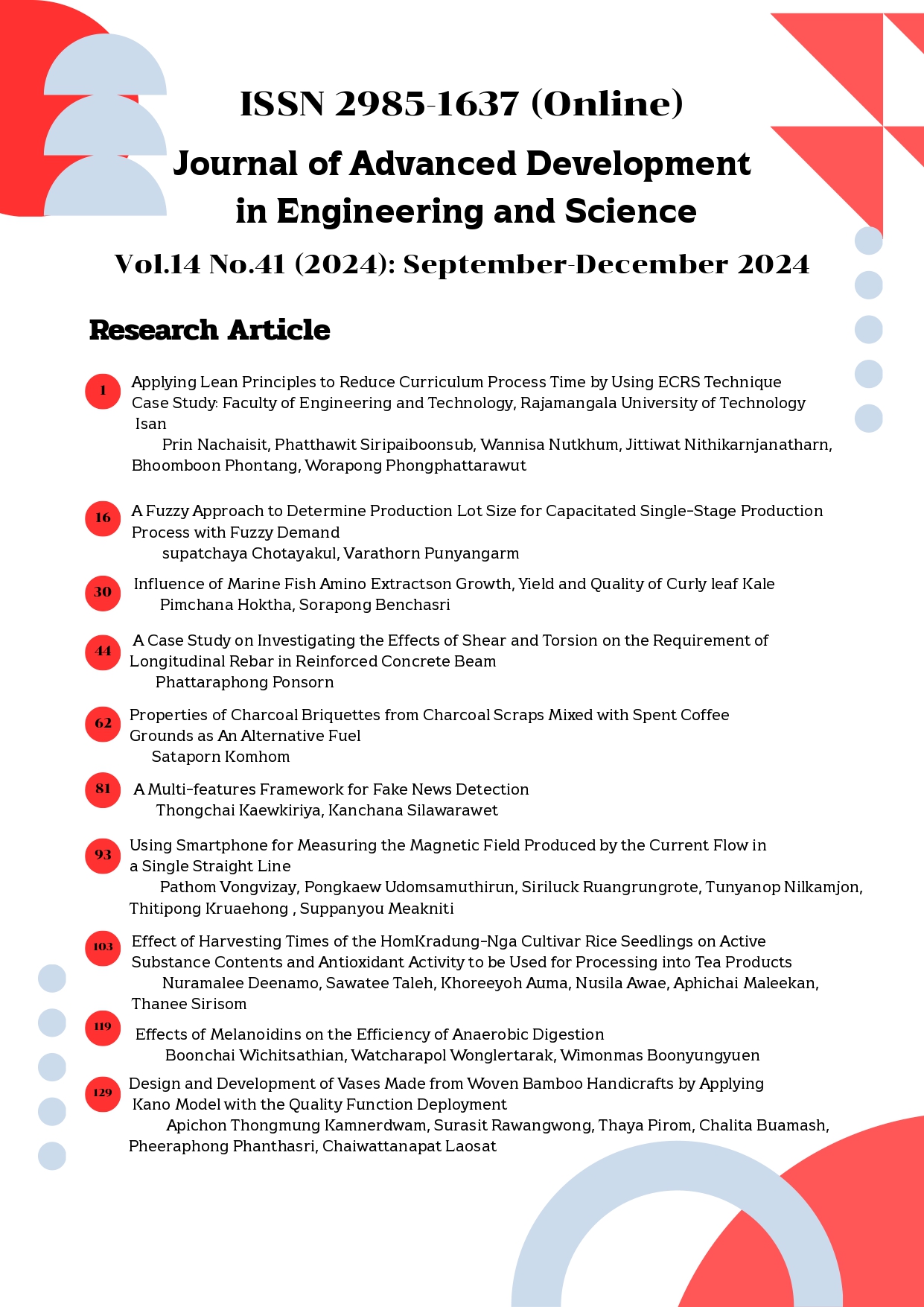สมบัติของถ่านอัดแท่งจากเศษถ่านผสมกากกาแฟใช้แล้วเพื่อเป็นเชื้อเพลิงทดแทน
Main Article Content
บทคัดย่อ
งานวิจัยนี้มีวัตถุประสงค์เพื่อวิเคราะห์สมบัติของถ่านอัดแท่ง กรรมวิธีการผลิตใช้เศษถ่านหลังจากการเผาวัสดุชีวมวลนำมาผ่านการคัดเลือกจากตะแกรงร่อนที่มีขนาดเล็กกว่า 2.36 มิลลิเมตร ผสมกับกากกาแฟใช้แล้วที่ทิ้งจากเครื่องชงกาแฟแรงดันไอน้ำ โดยนำไปอบให้แห้งก่อนที่อุณหภูมิ 110 oC เป็นเวลา 24 ชั่วโมง ทำการปรับอัตราส่วนโดยน้ำหนักของเศษถ่าน กากกาแฟและกาวแป้งความเข้มข้นร้อยละ 5 โดยน้ำหนัก รวมทั้งเปรียบเทียบตัวอย่างที่ไม่ผสมกลีเซอรีนและผสมกลีเซอรีนลงในกาวแป้ง หลังจากการวิเคราะห์สมบัติของถ่านอัดแท่งแล้วพบว่าที่อัตราส่วนโดยน้ำหนักของเศษถ่านต่อกากกาแฟเท่ากับ 3:1 และ 3:2 และมีการผสม กลีเซอรีนลงไปในกาวแป้งเป็นเงื่อนไขที่มีความเป็นไปได้ที่จะเลือกใช้ในการผลิตถ่านอัดแท่งที่สามารถใช้งานได้ดี โดยมีค่าพื้นที่ผิว 7.95 และ 4.97 m2/g ความหนาแน่น 467.36 และ 484.09 kg/m3 เปอร์เซ็นต์การแตกหัก 2.22% และ 1.45% และมีค่าความร้อน 23.43 และ 21.84 MJ/kg ตามลำดับ การทดสอบการให้ความร้อนกับน้ำ 500 g ด้วยถ่านอัดแท่งจำนวน 4 แท่ง พบว่าอัตราส่วน 3:1 และ 3:2 ที่ผสมกลีเซอรีนให้อุณหภูมิสูงสุดเท่ากับ 71 และ 66 oC ตามลำดับ และตัวอย่างทั้งสองมีระยะเวลาในการให้ความร้อนเพิ่มขึ้นประมาณ 20 นาทีเมื่อเทียบกับตัวอย่างที่อัตราส่วนเดียวกันที่ไม่ผสมกลีเซอรีน
Article Details

อนุญาตภายใต้เงื่อนไข Creative Commons Attribution-NonCommercial-NoDerivatives 4.0 International License.
เนื้อหาและข้อมูลในบทความที่ลงตีพิมพ์ใน Journal of Advanced Development in Engineering and Science ถือเป็นข้อคิดเห็นและความรับผิดชอบของผู้เขียนบทความโดยตรง ซึ่งกองบรรณาธิการวารสารไม่จำเป็นต้องเห็นด้วยหรือร่วมรับผิดชอบใดๆ
บทความ ข้อมูล เนื้อหา ฯลฯ ที่ได้รับการตีพิมพ์ในJournal of Advanced Development in Engineering and Science ถือเป็นลิขสิทธิ์ของ Journal of Advanced Development in Engineering and Science หากบุคคลหรือหน่วยงานใดต้องการนำทั้งหมดหรือส่วนหนึ่งส่วนใดไปเผยแพร่ต่อหรือเพื่อกระทำการใดๆ จะต้องได้รับอนุญาตเป็นลายลักษณ์อักษรจาก Journal of Advanced Development in Engineering and Scienceก่อนเท่านั้น
เอกสารอ้างอิง
Nikiforov, A., et al. (2023). Analysis of the Characteristics of Bio-Coal Briquettes from Agricultural and Coal Industry Waste. Energies, 16(8), 3527.
King Mongkut's University of Technology North Bangkok. (2021). Study of impacts on the electrical system (production system, transmission system, and distribution system) from electricity production from renewable energy and solutions. (Research reports). Bangkok: Institute of Technological Development for Industry (ITDI). (in Thai)
Energy Policy and Planning Office, Ministry of Energy. (2023). Energy overview for January 2023. Available from https://www.eppo.go.th/images/Energy-Statistics/ energyinformation/Energy_Statistics/00All.pdf. Accessed date: 12 March 2024. (in Thai)
Susanto, A. & Yantom, T. (2013). Biocharcoal briquettes from palm empty shells and bunches. Jurnal Teknologi Hasil Pertanian, 6(2), 68-81.
Tamilvanan, A. (2013). Preparation of biomass briquettes using various agroresidues and waste papers. Journal of Biofuels, 4(2), 47-55.
Wilaipon, P. (2007). Physical characteristic of maize cob briquettes under moderate die pressure. American Journal of Applied Sciences, 4(12), 995-998.
Sunardi, S., et al. (2019). Characteristics of Charcoal Briquettes from Agricultural Waste with Compaction Pressure and Particle Size Variation as Alternative Fuel. International Energy Journal, 19(3), 139-148.
Rerkkumsup, P., et al. (2020). The Development of an Automatic Control System for Charcoal Briquettes Drying. Pathumwan Academic Journal, 10(27), 70-83. (in Thai)
Brunerová, A., et al. (2020). Valorization of Bio-Briquette Fuel by Using Spent Coffee Ground as an External Additive. Energies, 13(1), 54.
Elanda, F. & Citra, S. (2018). Study on the use and composition of bio-charcoal briquettes made of organic waste. Journal of Ecological Engineering, 19(2), 81-88.
Patabang, D. (2013). Thermal characteristics of meranti wood sawdust charcoal briquettes. Mechanical Journal, 4(2), 410-415.
Carnaje, N. P., et al. (2018). Development and characterisation of charcoal briquettes from water hyacinth (Eichhornia crassipes)-molasses blend. PLOS ONE, 13(11), e0207135.
Kpelou, P., et al. (2019). Energy Efficiency of Briquettes Derived from Three Agricultural Waste’s Charcoal Using Two Organic Binders. Journal of Sustainable Bioenergy Systems, 9(2), 79-89.
Onukak, I. E., et al. (2017). Production and characterization of biomass briquettes from tannery solid waste. Recycling, 2(4), 17.
Ikelle, I., et al.(2020). Thermal Analyses of Briquette Fuels Produced from Coal Dust and Groundnut Husk. Acta Chemica Malaysia, 4(1), 24-27.
Gómez-de la Cruz, F. J., et al. (2015). A vital stage in the large-scale production of biofuels from spent coffee grounds: The drying kinetics. Fuel Processing Technology, 130, 188-196.
Ballesteros, L. F., et al. (2014). Chemical, functional, and structural properties of spent coffee grounds and coffee silverskin. Food and bioprocess technology, 7(12), 3493-3503.
Tsai, W. T., et al. (2012). Preparation and fuel properties of biochars from the pyrolysis of exhausted coffee residue. Journal of Analytical and Applied Pyrolysis, 93, 63-67.
Rajaseenivasan, T., et al. (2016). An investigation on the performance of sawdust briquette blending with neem powder. Alexandria Engineering Journal, 55(3), 2833-2383.
Lehmann, J. & Joseph, S. (2009). Biochar for environmental management: Science and technology. London: Earthscan.
Porol, J. T. C., et al. (2019). Performance evaluation of charcoal briquettes derived from sugarcane tops using vinasse as binder. In IEEE 11th International Conference on Humanoid, Nanotechnology, Information Technology, Communication and Control, Environment, and Management (HNICEM) (p.1-5). 29 November – 1 December, 2019, Laoag, Philippines.
Aransiola, E.F., et al. (2019). Effect of binder type, binder concentration and compacting pressure on some physical properties of carbonized corncob briquette. Energy Reports, 5, 909-918.
Wilaipon, P. (2008). The effect of briquetting pressure on banana peel briquette and banana waste in northern Thailand. American Journal of Applied Sciences, 6(1), 167-171.
Ajimotokan, H.A., et al. (2019). Combustion characteristics of fuel briquettes made from charcoal particles and sawdust agglomerates. Scientific African, 6, e00202.

